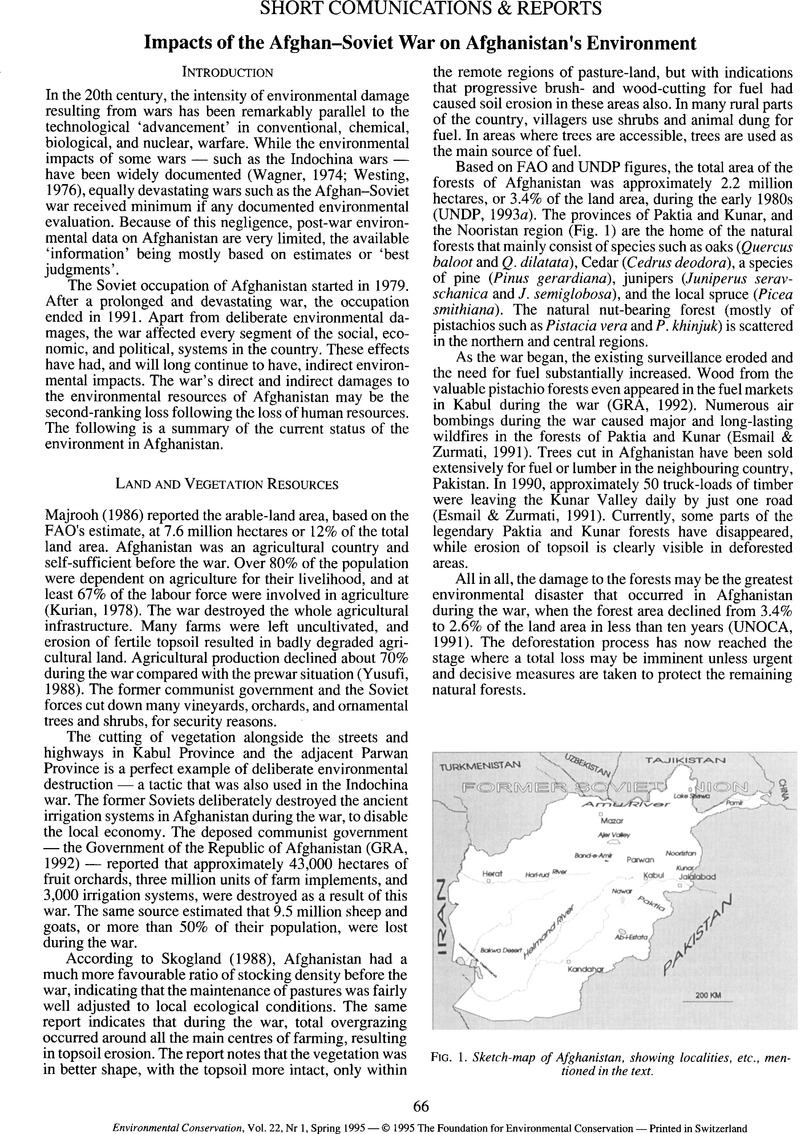Crossref Citations
This article has been cited by the following publications. This list is generated based on data provided by Crossref.
Dudley, Joseph P.
Ginsberg, Joshua R.
Plumptre, Andrew J.
Hart, John A.
and
Campos, Liliana C.
2002.
Effects of War and Civil Strife on Wildlife and Wildlife Habitats.
Conservation Biology,
Vol. 16,
Issue. 2,
p.
319.
Baral, Nabin
and
Heinen, Joel T.
2005.
The Maoist people's war and conservation in Nepal.
Politics and the Life Sciences,
Vol. 24,
Issue. 1-2,
p.
2.
Baral, Nabin
and
Heinen, Joel T.
2005.
The Maoist people's war and conservation in Nepal.
Politics and the Life Sciences,
Vol. 24,
Issue. 1 & 2,
p.
2.
Naoufal, Nayla
2010.
Éducation relative à l’environnement, dialogue intercommunautaire et apprentissage du vivre-ensemble.
Éducation et francophonie,
Vol. 37,
Issue. 2,
p.
186.
Kanderian, Nina
Lawson, David
and
Zahler, Peter
2011.
Current status of wildlife and conservation in Afghanistan.
International Journal of Environmental Studies,
Vol. 68,
Issue. 3,
p.
281.
Groninger, John W.
and
Lasko, Richard J.
2011.
Water for agriculture: challenges and opportunities in a war zone.
Water International,
Vol. 36,
Issue. 6,
p.
693.
Kretser, Heidi E.
Johnson, McKenzie F.
Hickey, Lisa M.
Zahler, Peter
and
Bennett, Elizabeth L.
2012.
Wildlife trade products available to U.S. military personnel serving abroad.
Biodiversity and Conservation,
Vol. 21,
Issue. 4,
p.
967.
Walters, S. Alan
Groninger, John W.
and
Myers, Oval
2012.
Rebuilding Afghanistan's Agricultural Economy.
Outlook on Agriculture,
Vol. 41,
Issue. 1,
p.
7.
Johnson, McKenzie F.
Kanderian, Nina
Shank, Christopher C.
Rahmani, Haqiq
Lawson, David
and
Smallwood, Peter
2012.
Setting priorities for protected area planning in a conflict zone – Afghanistan’s National Protected Area System Plan.
Biological Conservation,
Vol. 148,
Issue. 1,
p.
146.
Groninger, John W.
2012.
Reforestation Strategies Amid Social Instability: Lessons from Afghanistan.
Environmental Management,
Vol. 49,
Issue. 4,
p.
833.
2013.
Sustaining Rural Afghanistan under Limited Central Government Influence.
Stability: International Journal of Security & Development,
Vol. 2,
Issue. 2,
p.
24.
Sahoo, Sasmita
Puyravaud, Jean-Philippe
and
Davidar, Priya
2013.
Local Knowledge Suggests Significant Wildlife Decline and Forest Loss in Insurgent Affected Similipal Tiger Reserve, India.
Tropical Conservation Science,
Vol. 6,
Issue. 2,
p.
230.
Groninger, John W.
and
Pense, Seburn L.
2013.
Expectations of Agricultural Extension Programmes among Local Agents and International Support Personnel in South-Eastern Afghanistan.
Outlook on Agriculture,
Vol. 42,
Issue. 1,
p.
17.
Wilson, Sigismond A.
and
Wilson, Cyril O.
2013.
Modelling the impacts of civil war on land use and land cover change within Kono District, Sierra Leone: a socio-geospatial approach.
Geocarto International,
Vol. 28,
Issue. 6,
p.
476.
Aziz Mohibbi, Abdul
and
Cochard, Roland
2014.
Residents’ resource uses and nature conservation in Band-e-Amir National Park, Afghanistan.
Environmental Development,
Vol. 11,
Issue. ,
p.
141.
Goswami, Rajkamal
and
Ganesh, T.
2014.
Carnivore and Herbivore Densities in the Immediate Aftermath of Ethno-Political Conflict: The Case of Manas National Park, India.
Tropical Conservation Science,
Vol. 7,
Issue. 3,
p.
475.
Wilson, Cyril
2014.
Spectral analysis of civil conflict-induced forced migration on land-use/land-cover change: the case of a primate and lower-ranked cities in Sierra Leone.
International Journal of Remote Sensing,
Vol. 35,
Issue. 3,
p.
1094.
Jacobs, Michael J.
Schloeder, Catherine A.
and
Tanimoto, Philip D.
2015.
Dryland agriculture and rangeland restoration priorities in Afghanistan.
Journal of Arid Land,
Vol. 7,
Issue. 3,
p.
391.
Ordway, Elsa M.
2015.
Political shifts and changing forests: Effects of armed conflict on forest conservation in Rwanda.
Global Ecology and Conservation,
Vol. 3,
Issue. ,
p.
448.
Stewart, A.K.
2016.
Transboundary Water Resources in Afghanistan.
p.
213.





